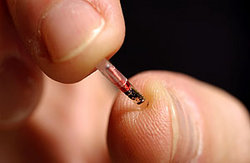|
From Wikipedia the free encyclopedia, by MultiMedia |
 A microchip impant
A microchip impantA microchip is an identifying integrated circuit placed under the skin of a Dog, cat, or other animal. The chips are about the size of a large grain of rice and are based on a passive RFID technology..
Tattooing is another, older method for identifying animals.
Microchips have been particularly useful in the return of lost pets. They can also assist where the ownership of an animal is in dispute.
Animal shelters and animal control centers benefit from microchipping by more quickly and efficiently returning pets to their owners. When a pet can be quickly matched to its owner, the shelter avoids the expense of housing, feeding, providing medical care, and outplacing or destroying the pet. Microchipping is becoming increasingly standard at shelters: many require all outplaced animals to receive a microchip, and provide the service as part of the adoption package.
In addition to shelters and veterinarians, microchips are used by kennels, breeders, brokers, trainers, registries, rescue groups, humane societies, clinics, farms, stables, animal clubs and associations, researchers and pet stores. Animal control officers are also trained and equipped to scan animals.
Effective pet identification and recovery depends on the following:
Many veterinarians perform test scans on microchipped animals every time the animal is brought in for care. This ensures the chip still performs properly. Vets sometimes use the chip ID as the pet's ID in their databases, and print this number on all outgoing paperwork associated with its services, such as receipts, test results, vaccination certifications, and descriptions of medical or surgical procedures.
Microchips are passive, or inert, RFID devices and contain no internal power source. They are designed so that they do not act until acted upon.
Three basic elements comprise most microchips: A silicon chip (integrated circuit); a core of ferrite wrapped in copper wire; and a small capacitor. The silicon chip contains the identification number, plus electronic circuits to relay that information to the scanner. The ferrite -- or iron -- core acts as a radio antenna, ready to receive a signal from the scanner. The capacitor acts as a tuner, forming a LC circuit with the antenna coil.
These components are encased in special biocompatible glass made from soda lime, and hermetically sealed to prevent any moisture or fluid entering the unit. Animals are not affected physically or behaviorally by the presence of a chip in their bodies.
Because microchips and scanners are manufactured by different companies, and different countries adopt their own standards, attempts have been made to establish a universal protocol that enables all microchips to be read by all scanners. This effort has not yet been successful.
The two companies which dominate the U.S. market -- AVID and HomeAgain -- both sell microchips which operate at a frequency of 125 kHz. This allows the scanner of one manufacturer to detect the presence of its competitor's microchip -- even if it cannot actually decode the chip's encoded or encrypted ID.
But in Canada, Europe, Asia and Australia, microchips for animals adopt a standard set by the International Organization for Standardization, or ISO, specifying that chips operate at 134.2 kHz.
When Banfield began selling Crystal Tag microchips in the U.S. -- chips made by Switzerland-based DATAMARS, and following ISO standards -- not enough scanners were distributed to ensure that these chips (with their different frequency) could be detected. Customers were not aware that far fewer shelters and clinics were equipped to detect these chips than the 125 kHz chips.
The situation is further complicated by the fact the AVID holds patents on 125 kHz technology, leading to legal disputes when non-U.S. based companies attempt to market 125 kHz systems in America. One solution is a scanner that will read both frequencies, known as a forwards-and-backwards scanner. These are slower and less reliable, and have not been widely distributed at shelters and clinic.
The industry seems to agree that before ISO chips are more widely distributed in the U.S., scanners that can read the chips should be widely distributed first, and a transition strategy should be in place.
In Dogs and cats, chips are usually inserted below the skin at the back of the neck, between the shoulder blades on the dorsal midline. The chip can often be manually detected by the owner by gently feeling the skin in that area. It stays in place as thin layers of connective tissue form around the biocompatible glass which encases it.
Horses are microchipped on the left side of the neck, half the distance between the poll and withers, and approximately one inch below the midline of the mane, into the nuchal ligament.
Birds' microchips are injected into their breast muscles. Because proper restraint is necessary, the operation requires two people -- an avian veterinarian and a trained assistant.
Many species of animals have been microchipped, including birds, horses, llamas, alpacas, goats, sheep, miniature pigs, rabbits, deer, ferrets, snakes, lizards, alligators, turtles, toads, frogs, rare fish, mice, and prairie Dogs -- even whales and elephants. The U.S. Fish and Wildlife Service uses microchipping in its research of wild bison, black-footed ferrets, grizzly bears, elk, white-tailed deer, giant land tortoises and armadillos.
Microchips are not in universal use, but there are legal requirements in some jurisdictions, such as the state of New South Wales, Australia. Some countries, such as Japan, require ISO-compliant microchips on Dogs and cats being brought into the country, or for the person bringing the pet into the country to also bring a microchip reader that can read the non-ISO-compliant microchip. [1]
Dogs, made by MultiMedia | Free content and software
This guide is licensed under the GNU Free Documentation License. It uses material from the Wikipedia.